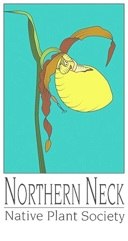Plant of the Month April 2024: Lyre-leaf Sage
Lyre-leaf Sage Flowers Whorls by Betsy Washington
Lyre-leaf Sage, Salvia lyrata
Northern Neck Chapter of the Virginia Native Plant Society
by Betsy Washington
A few weeks ago, driving north from Florida, we passed mile after mile of waves of lavender-blue flowers gracing the highway shoulders in South Carolina. We were thrilled to see Lyre-leaf Sage, Salvia lyrata, creating a gorgeous spectacle along an otherwise barren straight stretch of road. Later this month, Lyre-leaf Sage will be gracing our own roadsides, fields, and woodlands with beautiful racemes of lavender-blue flowers atop 1 – 2’ stems. Obviously this extravagant and beautiful abundance is a testament to the sheer adaptability and rugged nature of this native wildflower.
Lyre-leaf sage is an herbaceous perennial belonging to the Mint family and derives its common name from the elongate basal leaves with several rounded lobes, shaped somewhat like a lyre. These grow in a low ground hugging rosette each leaf with a long, hairy stalk. This rosette is evergreen persisting through the winter and adding color to our landscape; the dark green leaves often tinged purple or ornamented with distinctive purple veins. Then from mid-April until early summer, upright 4-angled hairy stems emerge from each rosette, topped with showy lavender flowers arranged in whorls or rings around the upper half of the stem. Each flower is about 1-1/2” long with distinctive. purplish-brown sepals at the base. Four to twelve flowers occur in each whorl; the flowers are funnel-shaped flaring out at the tip into two lips – the upper lip is small and divided into 3 rounded lobes while the lower lip is longer and notched, appearing ruffled. The effect is charming when you spy a few plants along a woodland path but absolutely spectacular in colonies.
In the wild, Lyre-leaf Sage grows in a wide variety of habitats from moist to dry forests to well-drained floodplains, to limestone barrens, and often along roadsides and in fields. It occurs in much of the eastern half of the United States and is common throughout Virginia.
This perennial can be somewhat short-lived but is self-perpetuated by seeding into any open or vacant spots. This can be used to advantage in a perennial border to prevent weeds from filling any gaps and by planting Lyre-leaf Sage in large masses or as a groundcover. This beautiful plant is highly adaptable and grows in full sun to partial shade and in dry soils or those that are occasionally wet. It even tolerates mowing and foot traffic and can be used as a lawn alternative. It can readily be propagated by division, seeds, or by rooted sections; it takes about 2 – 3 years to form a dense stand or groundcover and makes a superb low meadow plant.
In addition to its ornamental appeal, Lyre-leaf Sage is an excellent pollinator plant and attracts a variety of bees, butterflies, moths, and hummingbirds to its nectar-rich flowers. Birds, including Mourning Doves, relish the brown, nutty seeds. Like many members of the Mint family, deer, rabbits, and other mammalian herbivores find this plant distasteful and avoid it – making it a perfect choice for planting around more susceptible plants.
Lyre-leaf Sage is also sometimes called Cancerweed and was once (wrongly) believed to cure cancer. In fact, the generic name, Salvia, is derived from the Latin ‘salvare,’ meaning to save or heal alluding to the mild medicinal properties of this plant. Native Americans used an ointment made from the roots to treat sores and a medicinal tea from the leaves to treat colds and sore throats. Young leaves are edible with a “pleasant minty” taste and can be used in salads or cooked as a potherb.
Look for this lovely wildflower along the paths in Hickory Hollow or your favorite woodlands or marvel at the masses growing along our roadsides. Invite this adaptable plant into your garden where it will provide beauty while filling your gardens with butterflies, bees, and songbirds.
Clearwing Snowberry Moth Nectaring on Flowers by Betsy Washington
Flower Detail of flower by Anne Parker
Basal foliage by Betsy Washington
Lyre-leaf sage enlivens a May flower border by Betsy Washington





